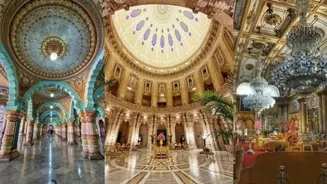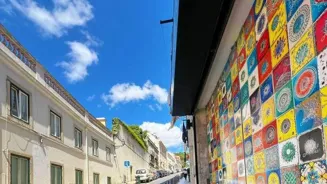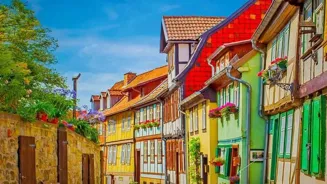Step inside India’s palaces where the ceilings don’t just look royal – they put on a show.
When we think of colour-changing skies, the Northern Lights often
steal the spotlight. But here’s the twist – you don’t need to freeze in the Arctic to witness magic in the air. In India, some royal ceilings have been attracting guests for centuries with their aurora-like hues, thanks to the genius of artists, architects, and a touch of royal drama. These aren’t just painted rooftops – they’re living canvases that play with light, seasons, and time.
From Rajasthan to Gujarat, from Madhya Pradesh to Karnataka, let’s explore five Indian palaces where the ceiling is part of the experience.
Umaid Bhawan Palace, Jodhpur – The Desert’s Colour Mirage

Imagine walking into a room where the ceiling seems to shift shades as the sunlight streams in. Umaid Bhawan Palace, an architectural wonder of the 20th century, isn’t just famous for its golden sandstone exterior – inside, its Art Deco-inspired halls are topped with intricately designed ceilings that respond to light like a desert mirage. The colour transitions, subtle yet stunning, were a clever combination of paint pigments, mirrorwork, and sunlight filtering through specially placed windows. It’s Rajasthan’s own version of mood lighting – centuries before it became a home décor trend.
Lukshmi Villas Palace, Vadodara – The Victorian Chameleon

Built in 1890, Lukshmi Villas Palace is four times the size of Buckingham Palace (yes, you read that right). While its European-style façade screams grandeur, step inside and you’ll observe ceilings that are anything but static. Crafted with stained glass and polished wood, the interiors glow in varying shades as sunlight pours through during different hours of the day. It’s Victorian engineering meeting Indian warmth – a royal social media filter, long before hashtags were a thing.
The City Palace, Udaipur – The Peacock Room’s Sky Dance

Udaipur’s City Palace is a fairytale in marble, but the real magic lies in its Mor Chowk or Peacock Room. Here, the ceiling doesn’t just hold the room together – it celebrates it. Studded with glass mosaics and tiny mirrors, the dome shifts colours as you move, reflecting blues, greens, and golds like a peacock in full display. It’s not just a ceiling – it’s a performance that changes with your perspective, making you part of the artwork.
Jai Vilas Palace, Gwalior – Where Crystal Meets Colour

Jai Vilas Palace is best known for its dining room chandeliers so massive they had to test the ceiling’s strength by marching elephants across it. But here’s what most tourists miss – certain state rooms have ceilings adorned with painted panels and mirrored details that subtly alter their shades under natural and artificial light. It’s the kind of royal indulgence where dinner wasn’t just about food – it came with a show overhead.
Palace of Mysore – The Southern Spectrum

If the North had its peacock blues and desert golds, the South brought in tropical vibrance. The Mysore Palace’s Kalyana Mantapa (marriage hall) has a stained-glass ceiling in geometric patterns that comes alive when the sun hits it, scattering colours across the polished marble floor. Walking here feels like stepping into a kaleidoscope – a southern twist on the aurora, with the bonus of sandalwood-scented air.
Apart from their obvious “wow” factor, these ceilings were a clever fusion of art, science, and status. Using mirrorwork, stained glass, pigments, and architectural positioning, artists manipulated natural light to create shifting colours throughout the day. It was a symbol of luxury – if your ceiling could change colour, it meant you had the means (and patience) to commission the finest artisans in the land.
Today, colour-changing LED lights and smart homes try to replicate what these royal architects achieved centuries ago – meanwhile, they did it without electricity. If anything, these ceilings prove that Indian design was never just about beauty – it was about experience.
Aurora? India’s royals had their own version first!










